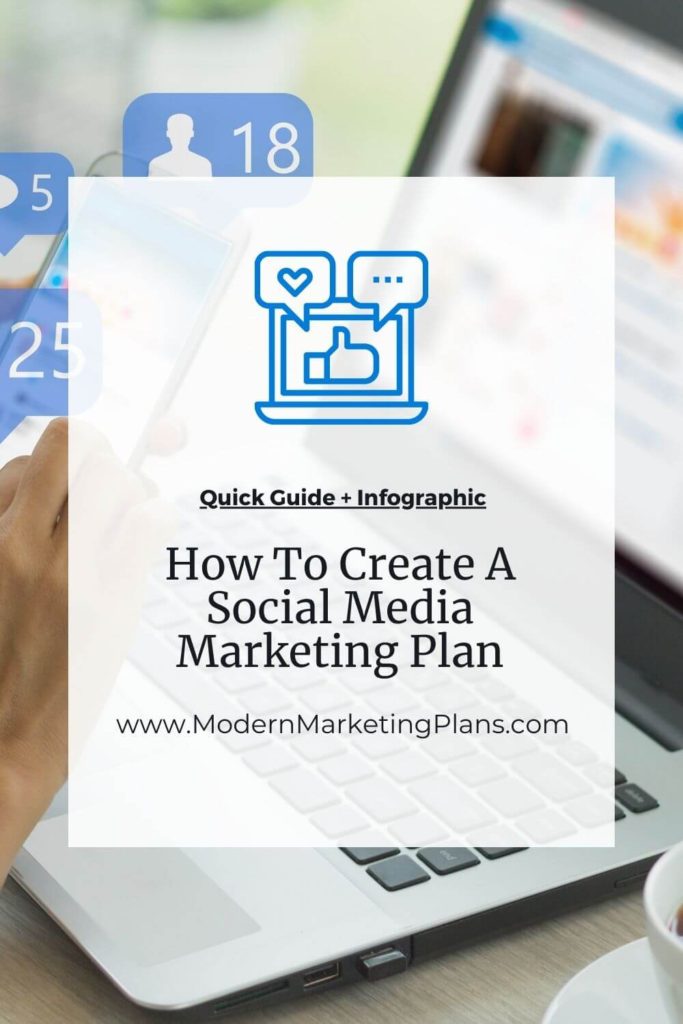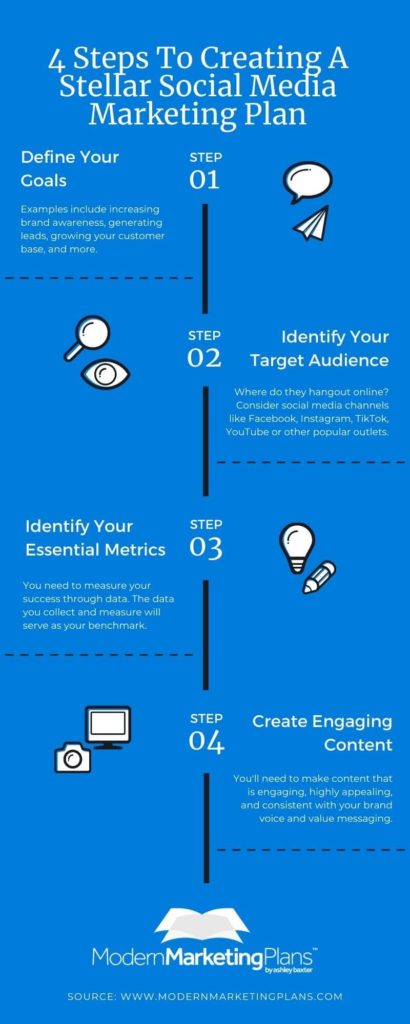Do you use social media as one of your main marketing channels?
Social media is a great way to connect with your customers globally. It’s also used as an important platform to increase customer retention. However, the problem is that many business owners are struggling to increase their engagement due to having a poor social media marketing plan.
In this article, you’ll learn how to create a great social media marketing plan to increase your followers and ultimately generate more leads and sales.
Steps in Creating a Great Social Media Marketing Plan
STEP 1: Define Your Social Media Marketing Goals
Before making a social media marketing plan, it’s important to define your end goals first. These goals will serve as the blueprint or backbone of your marketing plan and ensure that every action you take will bring you one step closer to success. Here are some examples of business goals a small business owner might create to improve their presence on social media.

Increase Brand Awareness
Having this goal means you need to convince customers to connect with your brand on a deeper level. It means you must focus more on building relevant content about your business that people are excited to engage with. Content that promotes how your products or services can benefit your customers is key.
Generate More Leads
Now that you’ve established brand awareness, the next phase of your social media marketing plan is to compel customers to take action. You can boost interest by offering free resources, promotions, and other valuable insights that will encourage readers to share their email addresses or phone numbers. This allows you to stay in touch with them outside of social media.
Increase Customer Base
This means introducing your brand to new customers. You can grow your audience by tapping into elements of your social media marketing plan like using popular hashtags based on your industry and being active on networks that are relevant to your demographic. It’ll give you insight into how the industry perceives your brand. After this, you’ll need to focus on increasing conversion and getting more sales.
Maintain Customer Engagement
This goal can help you look for ways to grab and keep your customer’s attention. You can achieve this by posting a question, asking for their feedback about your brand, launching a survey, or even hosting contests and giveaways to retain your valued clients.
Increase Website Traffic
If you’re concerned about increasing your website traffic and SEO rankings, then social media plays a vital role in achieving this goal. It has long been rumored that social signals are a positive factor in SEO ranking. While no one is quite sure how heavily they are factored into the algorithm, it is clear that they matter. You can also tap into the power of social bookmarking to get additional traffic to your website.
STEP 2: Identify Your Target Audience
The next phase in your social media marketing plan is identifying your audience. With the help of social media demographic tools, you’ll be able to identify your target customers. Knowing who your target customers are will allow you to choose the best social media platform to use for your strategy.

Here are some guides worth taking notes:
Facebook & Youtube – These platforms are great for hosting ads due to their high number of active monthly users.
Instagram – This platform has a high number of Gen Z users. You need to create mesmerizing content that is visually appealing and personally engaging.
Pinterest – You’ll find many people lurking on Pinterest for craft or shopping ideas. This is the perfect venue to showcase stunning images for social shoppers and drive them to your website to learn more.
Linkedin – If you’re a B2B company or if you want to expand your professional network, Linkedin is the best platform for your social media marketing plan. It’s important to share in-depth, specific, and formal types of content here since you’ll be connecting with business-minded individuals.
STEP 3: Identify Your Essential Metrics
The next step is to identify your metrics. Now that you’ve established your goals, you need to measure your success through data. The data you collect and measure will serve as your benchmark to determine whether or not your social media marketing plan works.
Here are some important metrics you need to keep an eye on:
- Reach – This refers to the number of unique subscribers or followers you saw your posts. How well is your content spreading across social media? Did it reach your target audience? Are you generating more reach through organic or paid posts?
- Clicks – Clicks refer to the action taken by your customers from your ads. Are they clicking the button to visit your website? Have they landed on your lead pages? Equipping your campaigns with analytics will help you understand what compels your customers and grabs their curiosity.
- Engagement – This metric goes hand in hand with your reach. This is a vital part of your social media marketing plan since it lets you determine how your customers perceive your content. Are they liking, sharing, or commenting on your posts? Are they responding to your questions? Did they take time to answer your questions or participate in your contests and events? Obtaining these answers through engagement reports will help shape your content as you evaluate your social media marketing plan.
STEP 4: Create Engaging Content
By this point, you pretty much have an idea of what type of content to publish based on your goals and brand. The next step of your social media marketing plan is putting it into action. Aside from making informative content through blog posts, you also need to make it engaging, highly appealing, and consistent. Here are some things to consider when creating your content:
Consistent Theme – It’s important to maintain a consistent theme for your brand. It can be a color scheme, structured design, or format. You can use social media graphic tools like Canva to organize your design. Make sure to put your brand’s logo or URL in your images. It doesn’t only serve as your watermark, but it also serves are your signature mark. Your customers will think of your business automatically the moment they see your visuals.
Types of Content – Fortunately, you’ll have many options to choose from when it comes to varying your content. You can include sharing blog posts, memes, inspirational quotes, infographics as part of your social media marketing plan. If you have the ability to include video content then that’s even better.
Scheduling – Scheduling is important to ensure you’ll have consistent updates on your social media pages. In case you don’t have time to draft your content on your pages manually, you can use social media scheduling tools like Hootsuite. This will help you ensure you’re up to date with your publishing schedule even if you’re busy in real life.

Conclusion
Figuring out where to start your social media marketing plan may be daunting, but we believe this comprehensive guide will help you get the hang of it. By following this plan, you’ll breeze through creating relevant and engaging content on your social media pages that will help increase your audience and customer base.





